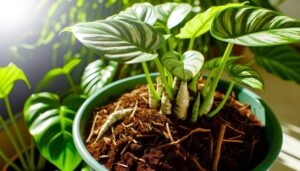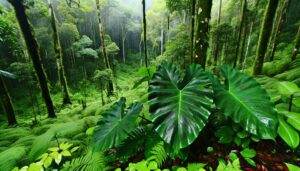Where Can I Find a Range Map for Philodendron Erubescens?
To locate a range map for Philodendron erubescens, consult botanical databases such as Tropicos, GBIF, and iNaturalist. These platforms offer interactive mapping tools and detailed taxonomic information.
University research centers and botanical gardens often collaborate on range mapping and ex-situ conservation efforts, providing authoritative sources. Additionally, exploring scientific journals and herbarium collections will yield precise geographical distribution data.
Online plant identification apps and platforms that aggregate user-contributed observations can further enhance data accuracy. For a more thorough understanding, consider exploring specific botanical and conservation institutions devoted to this species’ study.
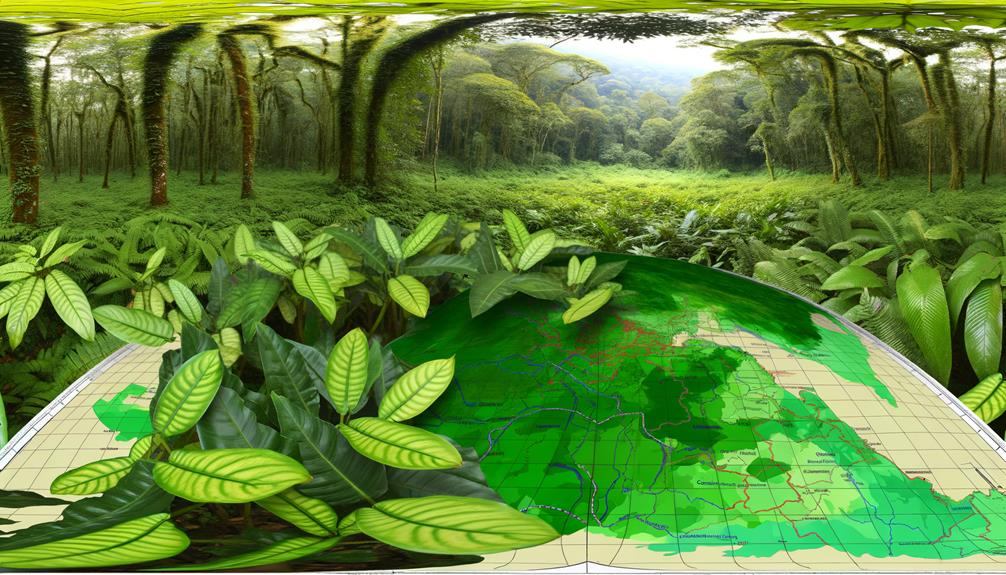
Key Takeaways
- Check online plant databases like GBIF and Tropicos for detailed distribution maps.
- Visit botanical gardens and institutions for herbarium specimens and range data.
- Utilize interactive mapping tools available on platforms like iNaturalist and GBIF.
- Explore university research centers’ publications for experimental range mapping studies.
- Refer to user-contributed maps on plant enthusiast forums and social media groups for real-time updates.
Botanical Gardens and Institutions
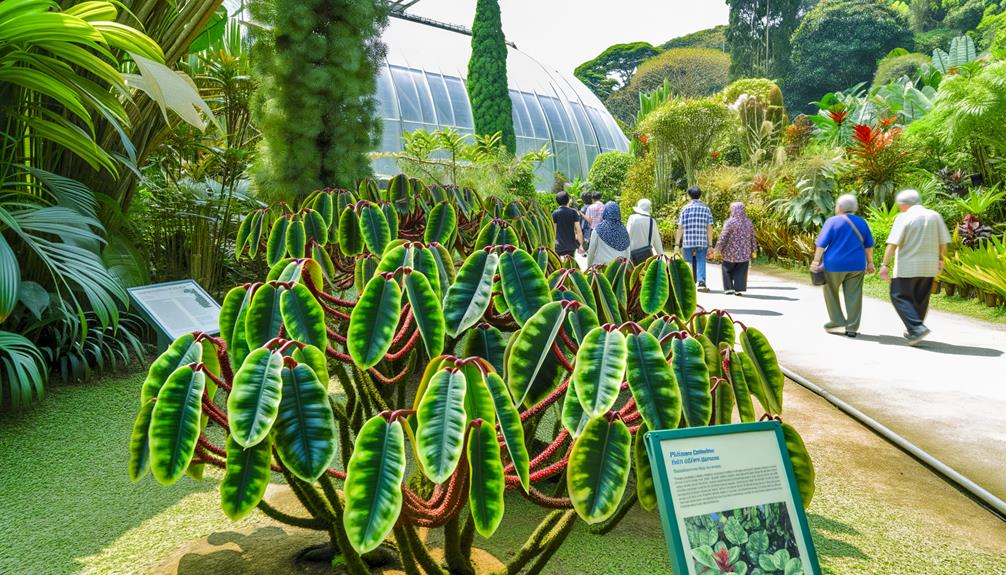
Botanical gardens and institutions play a crucial role in the conservation, study, and dissemination of Philodendron erubescens, providing invaluable resources for scientific research and public education.
These organizations maintain extensive living collections and herbarium specimens, enabling detailed physiological and morphological studies of this species.
Through ex-situ conservation efforts, botanical gardens protect genetic diversity, which is essential for the species’ resilience.
Moreover, these institutions collaborate internationally to exchange knowledge and propagate best practices in horticulture and conservation.
Educational programs disseminate crucial information about P. erubescens, raising public awareness and fostering appreciation for biodiversity.
Online Plant Databases
Online plant databases play a crucial role as reliable repositories of detailed botanical information and geospatial data. These platforms offer interactive mapping tools that allow for precise visualization of species distribution and habitat ranges.
Moreover, user-contributed maps on these databases help aggregate observational data, thereby enhancing our collective understanding of the geographical extent of plants like Philodendron erubescens.
Reliable Data Sources
A critical resource for accurate information on Philodendron erubescens distribution is the utilization of reputable online plant databases, which compile and verify botanical data from diverse scientific studies and herbarium records.
Key platforms like the International Plant Names Index (IPNI), Tropicos, and the Global Biodiversity Information Facility (GBIF) provide meticulously curated data.
These databases offer detailed taxonomic information, geographical distribution maps, and specimen collections. For instance, GBIF aggregates data from various global institutions, ensuring an inclusive dataset. Tropicos, managed by the Missouri Botanical Garden, provides access to nomenclatural information and bibliographic references.
Leveraging these reliable sources guarantees the accuracy and currency of data, which is crucial for researchers, conservationists, and horticulturists studying Philodendron erubescens.
Interactive Mapping Tools
Leveraging reliable data sources, researchers can enhance their understanding of Philodendron erubescens distribution through advanced interactive mapping tools available on leading online plant databases.
These platforms provide sophisticated functionalities that allow for the visualization, analysis, and interpretation of spatial data related to plant distributions. Essential databases include GBIF, iNaturalist, and Tropicos, each offering unique features and datasets.
| Database | Key Features |
|---|---|
| GBIF | Global biodiversity data, extensive datasets |
| iNaturalist | User observations, species identification |
| Tropicos | Botanical information, herbarium specimens |
Interactive tools facilitate geographic range mapping, enabling the examination of occurrence records and habitat preferences. By utilizing these databases, researchers can generate precise, data-driven insights into the biogeographical patterns of Philodendron erubescens.
User-Contributed Maps
User-contributed maps within online plant databases greatly enhance the granularity and accuracy of Philodendron erubescens distribution data by incorporating field observations and local knowledge from a diverse group of contributors. These platforms allow for real-time data updates and crowdsource information from botanists, horticulturists, and enthusiasts.
Key benefits include:
- Enhanced Coverage: Data from multiple geographic regions, including remote areas.
- Temporal Updates: Continuous input guarantees up-to-date distribution patterns.
- Verification Protocols: Peer review mechanisms for data validation.
- Diverse Data Points: Contributions encompass habitat specifics, phenology, and ecological interactions.
- User Engagement: Encourages community participation and knowledge sharing.
Such collaborative efforts result in a robust, dynamic resource that offers detailed insights into the species’ ecological range and adaptability.
Scientific Research Papers

Numerous scientific research papers have meticulously documented the ecological distribution, phenotypic variations, and genetic makeup of Philodendron erubescens, providing a thorough understanding of its range and adaptive characteristics.
Detailed studies utilizing phytosociological surveys and molecular phylogenetic analysis have delineated its native habitat in tropical rainforests of Central and South America.
Genetic sequencing techniques have identified specific alleles responsible for its adaptive traits, contributing to its resilience in diverse environmental conditions.
Phenotypic traits such as leaf morphology, pigmentation, and growth patterns have been extensively cataloged, linking them to specific climatic and edaphic factors.
This body of research serves as a pivotal resource for constructing accurate range maps, facilitating conservation efforts, and informing ecological management practices for this species.
Government Environmental Agencies
Building upon the extensive scientific research, government environmental agencies play a pivotal role in applying this knowledge to develop, implement, and regulate conservation strategies for Philodendron erubescens. These agencies utilize empirical data to create accurate range maps, which inform policy decisions and conservation priorities.
Key functions of government agencies include:
- Biodiversity Monitoring: Systematically tracking the distribution and abundance of Philodendron erubescens.
- Habitat Protection: Enforcing regulations to preserve critical habitats and ecosystems.
- Data Integration: Consolidating data from various research projects to enhance mapping accuracy.
- Public Awareness: Disseminating information to promote community involvement in conservation efforts.
- Legislation: Developing and enforcing laws aimed at protecting endangered species and their habitats.
These coordinated efforts guarantee the sustainable management of Philodendron erubescens populations.
Conservation Organizations
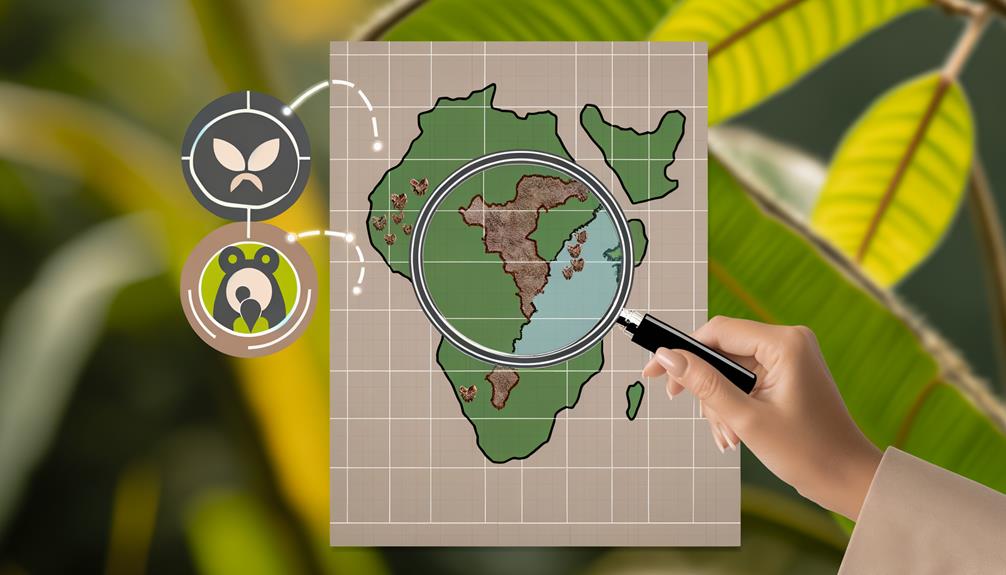
Conservation organizations play a pivotal role in safeguarding Philodendron erubescens by implementing focused preservation strategies and habitat restoration initiatives.
Key conservation efforts are often conducted in collaboration with research institutions, which provide critical data on species distribution, genetic diversity, and ecological requirements.
These partnerships enable a holistic approach to conservation, integrating field research with policy advocacy and community engagement.
Key Conservation Efforts
Various organizations, including the International Union for Conservation of Nature (IUCN) and Botanic Gardens Conservation International (BGCI), have implemented targeted conservation strategies to protect the Philodendron erubescens in its natural habitat. These strategies involve scientific research and habitat management to safeguard the species’ sustainability.
Key conservation efforts include:
- Habitat Restoration: Rehabilitating degraded areas to reestablish natural ecosystems.
- Ex Situ Conservation: Cultivating plants in botanical gardens to secure genetic diversity.
- Protected Areas: Designating and managing reserves to shield natural populations.
- Public Awareness Campaigns: Educating local communities about the species’ ecological importance.
- Policy Advocacy: Influencing environmental policies for stronger legal protections.
These initiatives are crucial for mitigating threats such as habitat loss, climate change, and illegal collection.
Collaborating Research Institutions
Several prominent research institutions are collaborating to enhance the conservation efforts for Philodendron erubescens, leveraging advanced scientific methodologies and interdisciplinary expertise.
The Royal Botanic Gardens, Kew, utilizes geospatial analysis and herbarium records to map species distribution.
Similarly, the Missouri Botanical Garden employs phylogenetic studies to understand genetic diversity and population structure.
The International Union for Conservation of Nature (IUCN) integrates these datasets to assess the conservation status and formulate strategies.
Additionally, the American Society of Plant Taxonomists (ASPT) contributes taxonomic revisions, ensuring accurate species identification.
These collaborations not only facilitate the creation of inclusive range maps but also support in situ and ex situ conservation initiatives, essential for safeguarding this vulnerable species’ ecological niche.
Plant Identification Apps
Leveraging advancements in artificial intelligence and machine learning, plant identification apps have become invaluable tools for botanists and hobbyists seeking precise identification of Philodendron erubescens. These applications utilize image recognition algorithms and extensive botanical databases to accurately classify plant species.
Critical features include:
- High-definition image analysis: Captures intricate leaf patterns and colors.
- Geotagging capabilities: Provides geographical data correlating to plant locations.
- Taxonomic references: Access to detailed taxonomic hierarchies and nomenclature.
- User-contributed data: Crowdsourcing information enhances database accuracy.
- Offline functionality: Essential for fieldwork in remote areas with limited connectivity.
These technological tools greatly enhance the efficiency and accuracy of plant identification, contributing to the broader understanding and documentation of plant biodiversity.
University Research Centers

University research centers play a pivotal role in advancing the scientific understanding of Philodendron erubescens through rigorous experimental studies and extensive fieldwork. These centers often have access to thorough herbarium collections, which assist in the accurate mapping of this species’ geographical distribution.
Utilizing Geographic Information Systems (GIS) and remote sensing technologies, researchers can generate precise range maps. Molecular phylogenetics and population genetics studies conducted within these institutions provide insights into the genetic variability and evolutionary history of P. erubescens.
Collaborations with botanical gardens and field stations enhance the scope of data collection, ensuring that range maps reflect both current and historical distributions. Therefore, university research centers are indispensable for generating reliable and scientifically validated range maps for Philodendron erubescens.
Plant Enthusiast Forums
Plant enthusiast forums serve as a valuable hub for community recommendations. Members share cultivation techniques and geographic distribution patterns of Philodendron erubescens.
Expert insights from horticulturists and botanists within these forums provide authoritative information and nuanced understanding of the plant’s ecological preferences.
Additionally, these platforms often host user-generated map resources that contribute to a thorough range map, enhancing the collective knowledge base.
Community Recommendations
Numerous plant enthusiast forums, such as those on specialized horticultural websites and social media platforms, provide a wealth of community recommendations for cultivating Philodendron erubescens.
These forums often feature detailed discussions on the species’ ideal growing conditions, propagation techniques, and pest management strategies. Community members share empirical data and specific methodologies to enhance plant health and growth.
- Light Requirements: Bright, indirect light to simulate natural understory conditions.
- Soil Composition: Well-draining, aerated soil mixtures with organic matter.
- Humidity Levels: Maintaining high humidity, ideally between 60-80%, mimicking tropical environments.
- Watering Schedule: Consistent moisture without waterlogging, ensuring proper root aeration.
- Fertilization: Balanced, water-soluble fertilizers applied monthly during the growing season.
These collective insights are invaluable for both novice and experienced horticulturists aiming for thriving Philodendron erubescens specimens.
Expert Insights
Delving into the expert insights shared on plant enthusiast forums reveals advanced cultivation techniques and scientific methodologies for optimizing the growth of Philodendron erubescens. Contributors often discuss the importance of precise humidity control, recommending levels between 60-80% to mimic the plant’s native tropical environments.
Additionally, they emphasize the critical role of soil aeration and drainage, advocating for substrates enriched with organic matter and perlite. Fertilization regimens are meticulously outlined, with a focus on balanced, slow-release fertilizers applied bi-monthly during the growing season.
Light requirements are another focal point, with experts suggesting diffused, indirect sunlight to prevent leaf scorch while ensuring adequate photosynthesis. These forums act as invaluable repositories of collective botanical wisdom, enabling enthusiasts to cultivate thriving specimens.
Map Resources
Several online plant enthusiast forums provide detailed map resources that outline the geographical distribution and native habitats of Philodendron erubescens. These platforms are invaluable for researchers and hobbyists seeking to understand the biogeographical patterns of this species.
The forums often include:
- Geographical Information System (GIS) maps: Depicting precise coordinates and spatial data.
- Historical herbarium records: Offering data on specimen collection locations over time.
- Field observation reports: Submitted by botanists and field researchers.
- User-generated maps: Created by enthusiasts based on local sightings.
- Ecological niche models: Predicting potential distribution based on environmental variables.
Local Herbariums
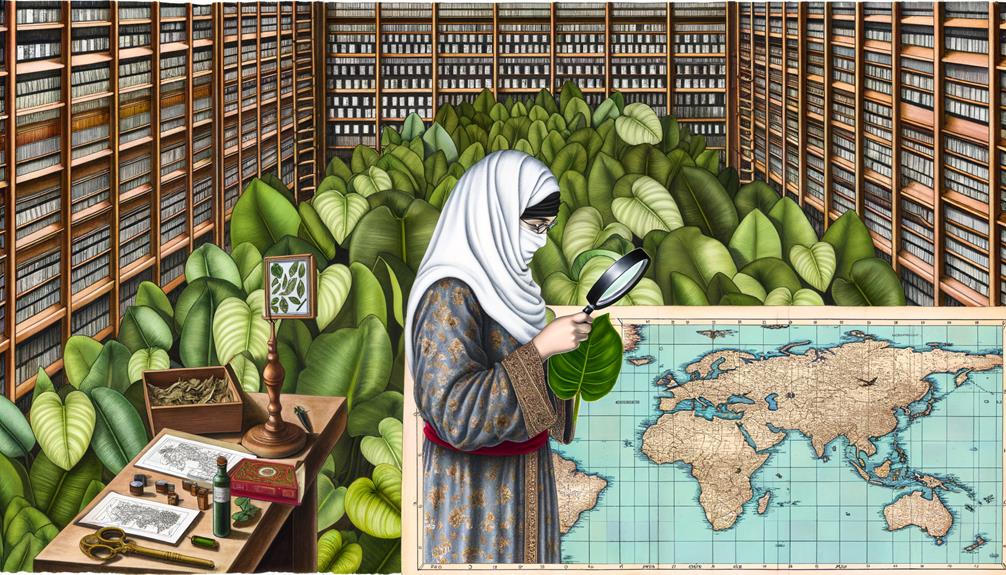
Local herbariums play an important role in the documentation and study of Philodendron erubescens, providing invaluable resources such as preserved specimens and detailed collection records that facilitate botanical research and conservation efforts.
These institutions offer access to meticulously cataloged plant materials, including herbarium sheets, which are necessary for understanding species distribution and ecological preferences.
The following table highlights key components of herbarium collections:
| Component | Description | Significance |
|---|---|---|
| Preserved Specimens | Dried and pressed plant samples | Reference for morphological studies |
| Collection Records | Data on collection location and date | Essential for mapping species range |
| Herbarium Sheets | Detailed documentation of plant attributes | Baseline for taxonomic research |
| Digital Databases | Online access to herbarium data | Facilitates global information sharing |
Herbariums thereby serve as repositories of botanical knowledge, aiding in accurate range mapping and species conservation.
Social Media Groups
In addition to the invaluable resources provided by herbariums, social media groups have emerged as dynamic platforms for the exchange of real-time information and field observations regarding Philodendron erubescens.
These groups serve as fertile ground for acquiring precise ecological data and enhancing species distribution models. Members often share geotagged photographs, which can be instrumental in refining range maps.
Key advantages of joining these groups include:
- Crowdsourced Data: Numerous contributors provide a broad data spectrum.
- Real-Time Updates: Up-to-the-minute observations from the field.
- Expert Insights: Direct access to botanists and experienced enthusiasts.
- Interactive Discussions: Facilitate nuanced understanding through dialogue.
- Global Reach: Observations from diverse biogeographic zones.
Philodendron Gloriosum Stem
The stem of a Philodendron Gloriosum is typically thick and short, serving primarily as a base from which the large leaves grow. It grows horizontally along the surface of the soil, often called a creeping or crawling stem.
This growth pattern allows the plant to spread outwards rather than upwards, supporting the large, heavy leaves and helping stabilize the plant as it matures. The stem’s surface is generally smooth with nodes spaced out, from which the roots and new leaves emerge.
Conclusion
In the quest for locating a range map for Philodendron erubescens, several credible sources can be consulted. Botanical gardens, online plant databases, and scientific research papers are invaluable resources.
Government environmental agencies and conservation organizations also offer pertinent data. University research centers and local herbariums provide highly specialized knowledge.
Additionally, plant enthusiast forums and social media groups often share up-to-date information. As the adage goes, ‘Knowledge is power,’ and utilizing these sources guarantees thorough and accurate information.



